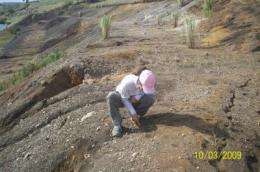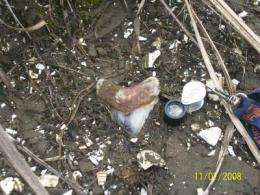Extinct giant shark nursery discovered in Panama

The six-foot-long babies of the world's biggest shark species, Carcharocles megalodon, frolicked in the warm shallow waters of an ancient shark nursery in what is now Panama, report paleontologists working at the Smithsonian Tropical Research Institute and the University of Florida.
"Adult giant sharks, at 60-70 feet in length, faced few predators, but young sharks faced predation from larger sharks," said Catalina Pimiento, visiting scientist at STRI and graduate student at the University of Florida. "As in several modern shark species, juvenile giant sharks probably spent this vulnerable stage of their lives in shallow water where food was plentiful and large predators had difficulty maneuvering."
Paleontologists from the Smithsonian and the University of Florida collected more than 400 fossil shark teeth from Panama´s 10-million-year-old Gatun Formation as part of ongoing work to reveal the origins of this narrow land-bridge that rose to connect North and South America about 3 million years ago. "The 28 teeth that we identified as C. megalodon were mostly from neonates and juveniles," said Pimiento. Researchers used reference collections at the Smithsonian's National Museum of Natural History and the Florida Museum of Natural History to characterize the teeth.

"Very little is known about the life cycle of this giant shark that ruled the oceans not so long ago. Now we think that the young spent their first years close to the coast among mangroves," said STRI staff scientist Carlos Jaramillo, who heads the Canal excavation project.
The team discarded several other explanations for the concentration of small teeth at the site. Before their discovery in Panama, two other fossil beds have been proposed as paleo-shark nurseries: the Williamsburg Formation from the Paleocene and the Oligocene Chandler Bridge Formation, both in the U.S. state of South Carolina.
The sandy soils of the Gatun Formation have been used for years to make cement. Soon these outcrops will be exhausted. Scientists continue to race against the clock to find out more about the ancient inhabitants of the region.
More information: Pimiento, C., Ehret, D., MacFadden, B., & Hubbell, G. (2010). Ancient Nursery Area for the Extinct Giant Shark Megalodon from the Miocene of Panama PLoS ONE, 5 (5) DOI: 10.1371/journal.pone.0010552
Provided by Smithsonian Tropical Research Institute


















